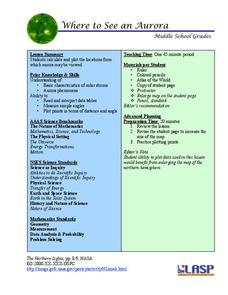Serendip
Where Does a Plant's Mass Come From?
Where does the mass for a growing tree come from? Scholars consider a few different hypotheses and guess which is correct. They then analyze data from different experiments to understand which concepts science supports.
Reed Novel Studies
Where The Mountain Meets The Moon: Novel Study
Does good fortune lie within the man in the moon? Minli, a young girl in Where the Mountain Meets the Moon, sure hopes it does, so she sets out to find the Old Man of the Moon for answers. Along the way, Minli meets several magical...
Curated OER
Going Graph-y
Second graders listen to and dicuss the story Where the Wild Things Are. They play a pantomime game and act out various feelings so their classmates can guess. They listen for the frequency of certain words, and record their findings on...
Curated OER
Where in the World is Mrs. Waffenschmidt? #9
Mrs. Waffenschmidt is off on another adventure, but where has she gone this time? After reading the informational passage, learners should be able to determine the man-made canal she's visiting. A wonderful way to introduce a little...
Curated OER
Where is the World is Mrs. Waffenschmidt? #18
Mrs. Waffenschmidt is off again, but where to this time? Use the informational text to uncover her mystery location. Your class will read facts and conclude that she is in the Sahara Desert. This is a good way to make informational text...
Curated OER
Where the Octopus Lives
In this letter O worksheet, students color a large picture of an octopus. Students analyze two pictures of habitats and circle the one that shows where an octopus would live. Students trace and practice upper and lower case letter Oo.
Curated OER
Where's the Bear?
Empower your kids to understand relative location through these practice images. They examine where the bear is relative to other objects in 10 images, checking off one of two prepositions. Once this has been completed, consider having...
Classroom Law Project
Who are the major candidates and where do they stand?
Who were the candidates in the 2008 US Presidential election and where did they stand on important issues? Use a resource that offers an opportunity to go back in time and examine candidates and issues involved in that election year.
Wind Wise Education
Where is it Windy?
How is the wind up there? The class builds a topography model using materials available in the classroom, then place wind flags in different locations on the landscape. Using a fan as a wind source, pupils collect data about how wind...
Journey Through the Universe
Where to Look For Life?
Every year we discover new planets including more than 1,000 in 2016 alone. Will we ever find life on another planet? The lesson includes two activities to help scholars understand this concept. First, they analyze the temperature range...
Curated OER
Where your food comes from
Students research where their favorite ingredients come from. In this ingredients lesson plan, students pick 2 ingredients and use the Internet to research where those ingredients originated from. Students then record their findings in a...
Curated OER
Quiz 1A: Using Where, When, What Time, and Why
Forming questions is an important skill for elementary learners to master. Using this 10 question short-answer activity, student use a prompt to form sentences beginning with where, when, what time, and why.
California Academy of Science
Where Do I Put My Trash?
Where does the trash go after you put it in the garbage can? The class discusses sustainability, recycling, compost, and landfills as they play as fun relay game. In teams, they race to be the fastest group to successfully sort their...
Curated OER
Where We Live
Who has the most? Young learners practice charting data using familiar information. They help fill out a classroom chart by recording the number of people, pets, televisions, etc. in their home. Guiding questions help them investigate...
Harper Collins
Let the Wild Rumpus Start!
Accompany a reading of the story, Where the Wild Things Are by Maurice Sendak, with an activity booklet featuring five worksheets created to continue to the learning experience. Scholars solve a maze, draw a picture, search for Max,...
Curated OER
Where
Kindergartners identify where a story takes place. For this literature lesson, learners take a picture walk and discuss how pictures can provide clues to the location of the story. They then illustrate where a new story of their own...
Alabama Learning Exchange
Who, What, When, Where, Why, How?
Your youngsters are just starting to read texts and pull out important information. Use this graphic organizer with any text to help them practice identifying the who, what, when, where, why, and how of a text. Although the format of the...
Curated OER
Where the Red Fern Grows Chapter 1 Worksheet
Break down Where the Red Fern Grows by Wilson Rawls into manageable chunks by focusing on plot points and literary elements in specific chapters. This resource is all about the first chapter, and asks pupils to use complete sentences to...
PHET
Where to See an Aurora
Where can you see an aurora in North America? After completing an astronomy activity, scholars can locate the exact coordinates. Pupils plot points of the inner and outer ring of the auroral oval and answer questions based on their...
EngageNY
Building Background Knowledge and Summarizing: “Refugees: Who, Where, Why” Part 2
What are some universal aspects of refugees' experiences worldwide and throughout history? Scholars read the text "Refugees: Who, Where, Why" and create two class anchor charts. Finally, they each write a paragraph that provides an...
EngageNY
Building Background Knowledge, Predicting, and Focusing on Key Vocabulary: “Refugees: Who, Where, Why”
Using the fourth of 20 lessons from the Grade 8 ELA Module 1, Unit 2 series, scholars discuss refugees' challenges when finding a place to call home. They also read and answer text-based questions about the informational passage...
EngageNY
Finishing Who? Where? and Why? Research
Who? Where? Why? Scholars answer these questions to help identify the gist of Inside Out & Back Again. First, they add text evidence to their research folders. They then begin looking at a performance task in which they write their...
Radford University
Where Should We Sit?
Where's the best seat in the house? Given a diagram of a movie theater, pupils determine the best seats based on the viewing angle. They use inscribed angles to justify their choices.
Center for History Education
Where Did Thomas Jefferson Stand on the Issue of Slavery?
Thomas Jefferson was a complicated man with a complex legacy. Middle schoolers examine a series of primary source documents to gather evidence for an essay in which they answer where Jefferson stood on the issue of slavery.
Other popular searches
- Where the Wild Things Are
- Where the Sidewalk Ends
- Where the Red Fern Grows
- Who What When Where Why How
- Where Food Comes From
- Who What Where When Why
- Where I Live
- Where the Lilies Bloom
- Choosing Where to Live
- Adjective Clauses Where When
- Adverbs How When Where
- Who What When Where

























